If you’re researching windows, you’ve probably come across a plethora of technical terms like, “window sash”, “stile”, “glazing bead”, or “muntins”.
And if you’re not a remodeling professional, you probably have questions.
Is the window sash the same as the window frame? What are the stiles and how do they differ from the rails”
In this article, we’ll explain exactly what a window sash is and give you an overview of its different components and styles.
So the next time a contractor tells you, “As you can see, this window sash has a glazing bead and this one doesn’t”, you'll know exactly what he’s talking about and why it’s important.
A window sash is a structural frame that holds the pane (or panes) of glass (often referred to as lights). It fits inside the overall window frame and can be either fixed or movable. Movable sashes may slide vertically in a double-hung or single-hung window, horizontally in sliding windows, or swing open like a door in the case of casement windows.
Components of a Window Sash
Window sashes typically have seven components: stiles, rails, muntins, glass panes(s), the glazing bead, weatherstripping, and the sash hardware.
Stiles
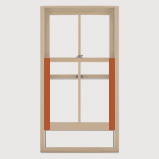
Stiles are the vertical components on the sides of the sash. They play a critical role in providing structural support to the sash and are a primary attachment point for the hardware used to open and close the window, such as hinges or sliders.
Rails

Rails are the horizontal components that form the top and bottom of the sash. The top rail often has a different profile than the bottom rail, especially in traditional designs, to accommodate the fitting of the sash within the window frame.
Muntins
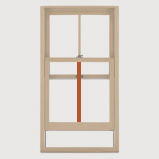
Muntins are the strips of wood, metal, or plastic that divide the window sash into smaller panes of glass. In historical windows, muntins physically held individual panes of glass. In modern windows, muntins may be purely decorative and are sometimes placed between two panes of glass for easy cleaning.
Glass Pane
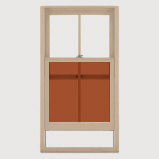
This is the glass part of the sash that provides visibility and light entry. The glass can be single, double, or triple-glazed, depending on the insulation needs. Modern windows may also include treatments to the glass such as tinting, low-emissivity (low-E) coatings, or inert gas fills between panes for improved energy efficiency.
Glazing Bead or Putty
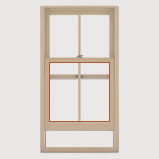
These materials hold the glass pane in place within the sash frame. In older windows, glazing putty is used, while in modern windows, the glass is often secured with vinyl or wooden glazing beads.
Weatherstripping
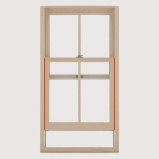
Weatherstripping is a material placed around the sash to seal it against drafts and moisture when it is closed. It improves the window’s thermal efficiency by preventing air leaks.
Hardware
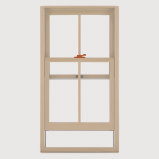
This includes all the mechanical elements used to operate the window, such as locks, latches, handles, and sometimes balance mechanisms that support the sash for easy movement. In casement windows, the hardware includes hinges and cranks.
Types of Window Sash Designs
The archetypal window sash (the one that probably comes to mind when you hear the term) is the double or single-hung window, which consists of two vertical sashes, one or both of which may slide up and down. But there are other types, like casement sashes and horizontal sashes.
Single-Hung Windows
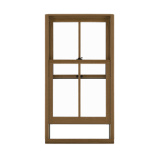
In single-hung windows, only the bottom sash is movable while the top sash remains fixed.
This design is traditional and widely used in residential properties.
Single-hung windows are simple and cost-effective, making them a popular choice.
Double-Hung Windows
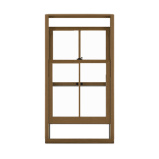
Both the top and bottom sashes in double-hung windows are operable, sliding vertically in the frame.
This design allows for better ventilation as air can flow through the top and bottom of the window.
Double-hung windows are also easier to clean, especially on multi-story buildings, because the sashes are often designed to tilt inward.
Casement Windows
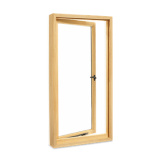
Casement windows feature a sash that is hinged on one side and opens outward to the left or right, usually operated by a crank.
The fact that they can be fully opened is a great feature that maximizes natural light and airflow.
Sliding Windows
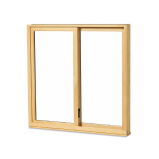
Sliding windows have sashes that move horizontally along the window frame.
They are ideal when an outward opening window is less practical, such as along patios or walkways.
Awning Windows
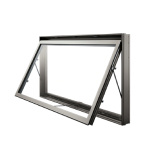
Awning windows have sashes that are hinged at the top and open outward from the bottom.
A nice benefit of awning windows is that you can open them during light rain since the glass acts like an awning.
They’re often used for basements, bathrooms, and kitchens.
Tilt-and-Turn Windows
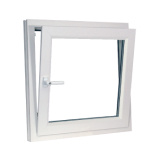
Tilt-and-turn windows have a unique sash style that is popular in Europe. In a tilt-and-turn window, the sash can either swing in like a door or tilt inward from the top to let fresh air in.
They’re great for ventilation and are easy to clean.
Full Window Replacement or Just the Glass?
If you're looking to replace your windows, you may be asking, should I replace the glass or the entire window? For the answer, check out our article on Full window replacement vs. Glass-only replacement: Which is right for you?

